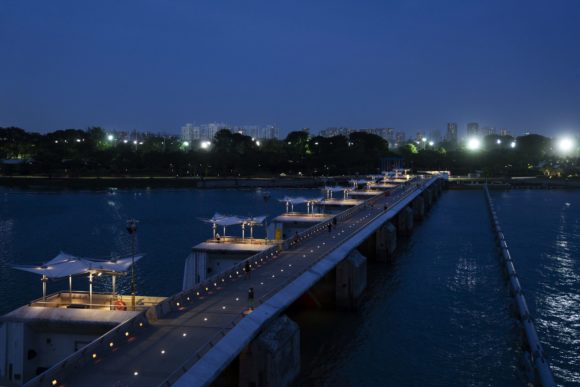Singapore has a reputation for planning ahead. When it comes to climate change, it’s planning for the worst.
While governments around the world are struggling to meet the goals of the Paris agreement — keeping the global temperature increase to about 1.5 degrees Celsius and the rise in sea levels to less than 0.5 meters — Singapore is devising a S$100 billion ($72 billion) plan to safeguard the city against temperatures and floodwaters several times those levels.
Analysis by the Meteorological Service Singapore’s Centre for Climate Research Singapore suggests that in a worst case scenario, floods could rise by almost 4 meters, factoring in effects like storm surges — an increase that would submerge cities from New York to Shanghai and London if repeated globally.
Prime Minister Lee Hsien Loong has called climate change a matter of “life and death,” an existential threat to the country as important as national defense. “Everything else must bend at the knee to safeguard the existence of our island nation,” Lee said in August at his National Day Rally — Singapore’s version of the State of Union address.
Singapore has reason to worry. According to the government weather service, the city has been warming twice as quickly as the world average over the past six decades, with temperatures rising about 0.25C per decade. It just had its hottest decade on record and if global carbon emissions keep rising at the current rate, daily temperatures could reach highs of 35C to 37C (95-99 Fahrenheit) by 2100.
At the heart of Singapore’s plan is a coastal adaptation study commissioned by the Building and Construction Authority in 2013 and submitted to the government last year. The BCA declined to provide details of the report, saying that the government is reviewing the findings, but the options for the government are expected to be wide and varied, from using mangrove to protect coastlines to flood-proofing subway stations and developing green “sponge” areas that can absorb floodwaters.
A Coastal and Flood Protection Fund will be set up with an initial S$5 billion, Finance Minister Heng Swee Keat said in his budget speech on Feb. 18. He said S$1 billion will be committed to research in urban solutions and sustainability, focusing on such things as renewable energy and cooling.
“If we start early and think long term, we can begin the preparation,” Heng, who is also deputy prime minister, said in a Bloomberg TV interview on Feb. 19. The fund “will allow us to take the measures that are necessary.”
A third of Singapore, including its central business district, is less than 5 meters above mean sea level. And the coastal plan could ultimately involve spending billions to encircle the country in protective polders and dykes or connecting a chain of offshore islands with barrages to create a giant reservoir, Lee had said.
“Is Singapore overreacting? No. Reality has so far overshot scientific projections of climate impacts,” said Vinod Thomas, visiting professor at the Lee Kuan Yew School of Public Policy in Singapore. “This is a necessary and perhaps a minimal insurance policy.”
The city is no stranger to pushing back the sea. Since its first reclamation project in the early 19th century, Singapore’s land area has grown by more than 25%. Drive 15 minutes east from the skyscrapers of the financial district and you’ll find a 15 kilometer (9 miles) stretch of beaches and parks where locals cycle, camp and barbecue satay and hotdogs.
It’s all man-made, part of a reclamation project in the 1960s and 70s that cost over S$600 million. Now Singapore wants to spend more than 100 times that over the next 50 to 100 years. That’s on top of hundreds of millions already spent on engineering projects to prevent flooding.
In 2008, the country opened the S$226 million Marina Barrage, which sealed off the Singapore River to create a reservoir and hold back the sea.
At its award-winning airport, workers are paving taxiways and carrying out piling work for a giant fifth terminal that would be bigger than all the other terminals combined. Designed to handle 150 million passengers a year when it’s completed around 2030, Terminal 5 is being built on higher ground, about 5.5 meters above the average sea level, and will include 10 kilometers of drainage to keep runways clear.
On the other end of the island, the city is building the world’s biggest container terminal at Tuas, where docks will be more than 5 meters above the current sea level.
The government in 2011 lifted the minimum reclamation level from 3 meters to 4 meters above sea level and has been raising the level of highways such as Nicoll Drive along the northeastern shoreline.
To fund the defense against global warming, the government expects individual ministries to pay for smaller-scale projects from their budgets. Bigger, long-term infrastructure like sea walls and land reclamation could mean selling debt or tapping state reserves, a major departure for a nation that has traditionally financed spending from tax revenue.
The idea is to make sure each generation contributes a fair share, without burdening future generations, said a spokesperson from the Ministry of Environment and Water Resources. With no hinterland to retreat to, Singapore has no choice but to invest long term to meet the impacts of climate change, the spokesperson said.
Singapore, the world’s third-richest nation by GDP per capita, can afford to pay, but poorer countries may not have such a luxury.
Like many rich countries that built their economies on fossil fuels, Singapore’s carbon footprint is big for its size. It has 0.0005% of the world’s land, but contributes around 0.11% of global emissions — bigger than some countries more than 50 times its size.
Christiana Figueres, one of the architects behind the Paris Agreement, once quipped that Singapore’s iconic Gardens by the Bay could become “Gardens beneath the Bay” if global emissions are not drastically reduced.
Singapore has pledged to reduce emissions intensity — a gauge of carbon output per unit of economic activity — by 36% between 2005 and 2030, the year it expects its emissions to peak. The government said it will update its target soon. The country generated 52.5 million tons of emissions in 2017.
Industry contributes 60% of the emissions and three-quarters of that comes from oil refining and petrochemicals, Senior Minister of State for Trade and Industry, Koh Poh Koon, told Parliament in October 2019.
Ironically, one of the most vulnerable parts of the country is Jurong Island, a flat area of largely reclaimed land just off the southwestern coast. It is one of the world’s largest oil refining and petrochemical complexes, with plants owned by Chevron Corp., Exxon Mobil Corp. and Royal Dutch Shell Plc.
It’s hard to overstate the importance of fossil fuels to Singapore’s economy. The city is home to the world’s third-largest oil trading hub, behind New York and London, and it is among the world’s top refining centers. The oil and gas sector is worth an estimated $80 billion, and Singapore gets 95% of its electricity from natural gas.
“Singapore cannot imagine a future burning oil and gas and think the rest will switch to low carbon,” said Thomas at the Lee Kuan Yew School. “If major players like Singapore do not wean themselves away from fossil fuel-based growth, climate change will accelerate and there will no longer be any growth.” He said Singapore’s goal should be zero net carbon emissions within 15 years.
One step Singapore is taking is Southeast Asia’s first carbon tax, levied at S$5 per ton on facilities that produce 25,000 tons of CO2 or more a year. The rate could rise to S$15 a ton by 2030.
The government is also investing in renewable energy, and wants solar panels to be able to power about a quarter of households by 2030. Even so, that would only be 4% of total energy demand, up from 1% now.
Part of the problem is that there’s very little land for big solar farms. Instead, the government plans to install panels on the rooftops of its 10,000 public housing buildings. Power company Sembcorp Solar Singapore also aims to build one of the world’s largest floating solar farms — the size of 45 football fields — on a reservoir.
After years with few electric vehicles on the streets, the government has started to embrace the technology, with the first fleet of public buses taking to the streets this year. Heng said the government plans to phase out vehicles with internal combustion engines by 2040.
Central to Singapore’s hotter future is securing its food supply. Less than 1% of the island is used for agriculture and the nation has to import 90% of its food.
With land prices among the highest in the world, trying to purchase plots from the government for farming is like “asking for the moon,” said Allan Lim, who grows rows of lettuces and basil in a greenhouse on the roof of an industrial building. His vertical farming company ComCrop is one of dozens of ventures that use technologies such as hydroponics and solar power to grow produce.
“We can’t rely on food imports forever,” said Lim, whose 38,000 square foot site produces up to six times more produce using 90% less water than a conventional farm of its size.
The Singapore Food Agency is carrying out a study on the effect of climate change on local farms and is targeting 30% locally produced food by 2030.
The real challenge facing the island, though, is water. Singapore has a network of reservoirs to catch most of its rainwater and is able to recycle about 40% of its water needs. By the end of this year, it will also have five desalination plants. The government says the new investments make it self-sufficient, yet it still buys imported water from Malaysia for a large part of its supply, especially during drier weather. And demand is expected to double by 2060.
The new coastal defense plan could create even bigger reservoirs. Meanwhile, the government is offering funding for companies to introduce water-saving technologies such as on-site recycling systems and encouraging the public to use water more efficiently.
One area where Singapore has been among the leaders is in urban design. In 2005, authorities introduced a voluntary green-building program for new projects that is transforming the city skyline, with towers and apartment complexes draped in greenery.
At least 80% of its buildings will meet those standards by 2030, and the government is developing even stricter rules that will promote super-low energy, zero-energy, and positive energy buildings, the spokesperson from the Ministry of Environment and Water Resources said.
One early example was the Parkroyal on Pickering, a hotel and office complex designed by 25-year-old Singapore-based architecture firm WOHA that was completed in 2013 and includes natural cooling from vegetation and wind and sensors that cut irrigation when rain is detected.
Other designs have been springing up across the island. CapitaGreen, a 40-storey office block completed in 2014 by the nation’s largest listed developer CapitaLand Ltd., has a petal-like structure at the crown of the building that draws in cool air at a height of 242 meters (794 feet).
Underneath the Marina Bay financial district lies one of the world’s largest district cooling networks, sending chilled water through 5 kilometers of pipes to air-condition buildings in the area. The system cuts cooling costs by more than 40%, according to operator SP Group.
As Singapore faces the prospect of having to adapt to a much warmer future, developers are now scrambling to embrace sustainability, said Richard Hassell, one of the co-founders of WOHA. “We like the panic,” he said. “We’ve been panicking for 25 years.”
Photograph: Singapore’s Marina Barrage houses nine crest gates that help regulate water levels. Photographer: Wei Leng Tay/Bloomberg.
Topics Climate Change
Was this article valuable?
Here are more articles you may enjoy.



 Owner of Historic Minnesota Resort Charged With Arson, Insurance Fraud
Owner of Historic Minnesota Resort Charged With Arson, Insurance Fraud  Trump Outlines Plan to Unwind Biden-Era Car Mileage Mandates
Trump Outlines Plan to Unwind Biden-Era Car Mileage Mandates  Viewpoint: Agentic AI Is Coming to Insurance Industry – Much Faster Than You Think
Viewpoint: Agentic AI Is Coming to Insurance Industry – Much Faster Than You Think  Acrisure CEO Greg Williams Makes $400M Commitment to Michigan State University
Acrisure CEO Greg Williams Makes $400M Commitment to Michigan State University 

